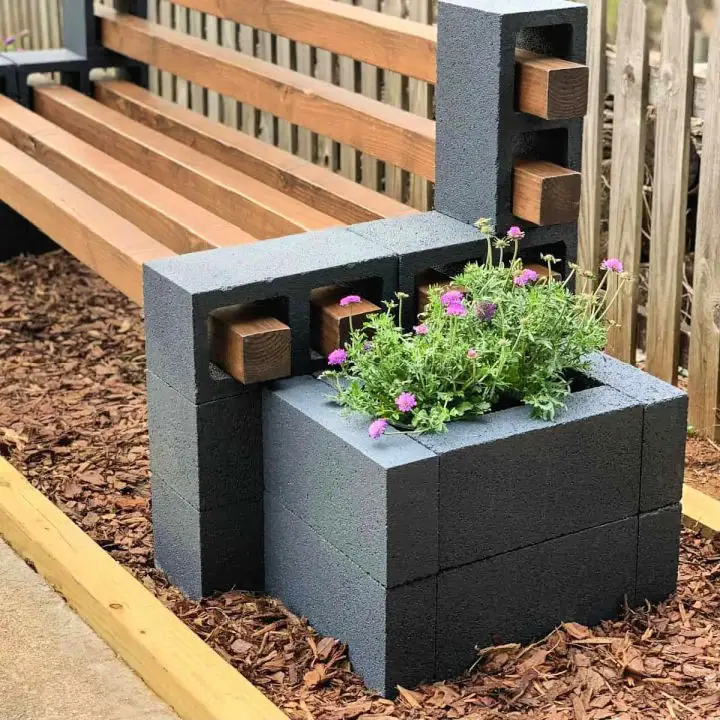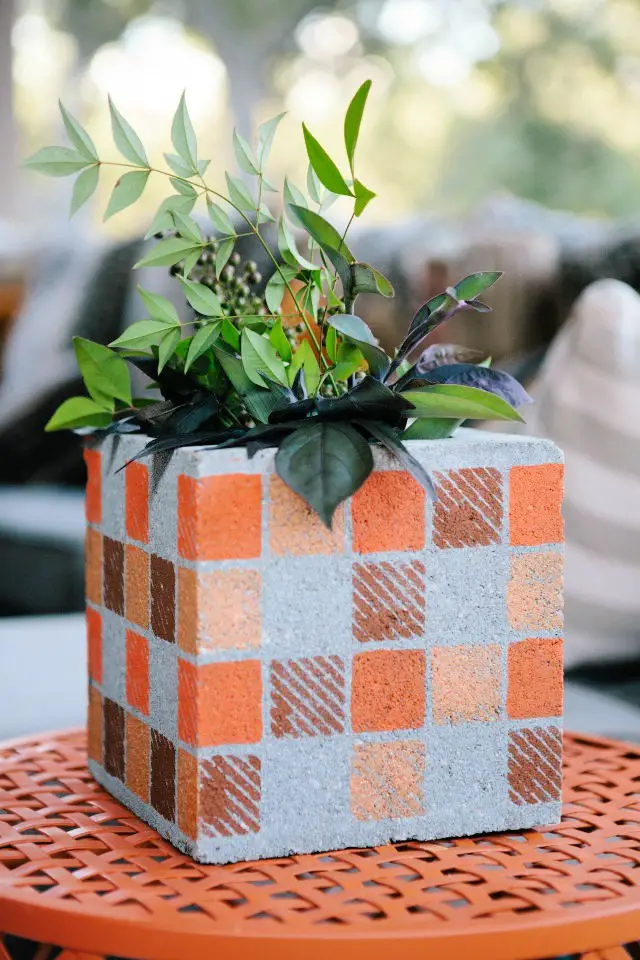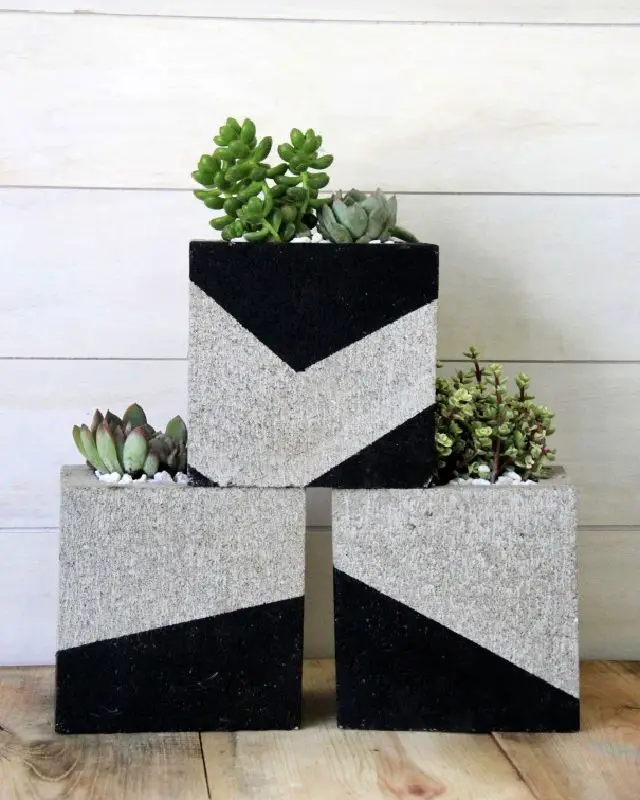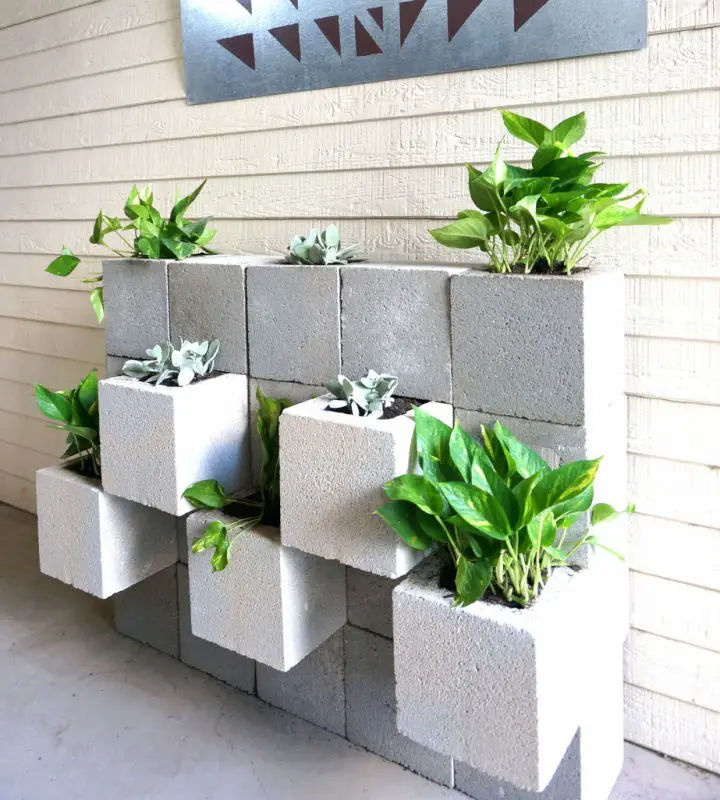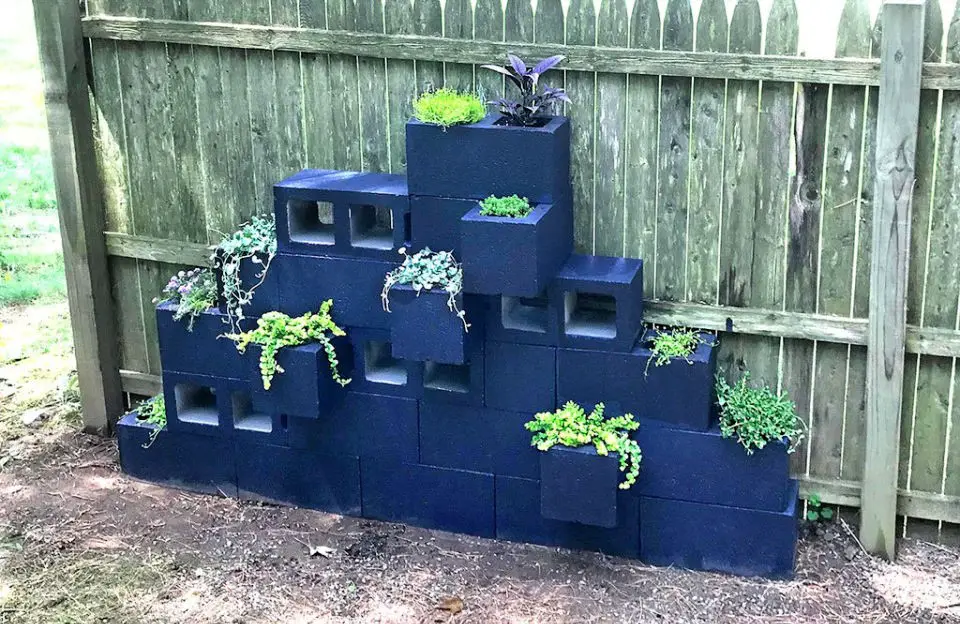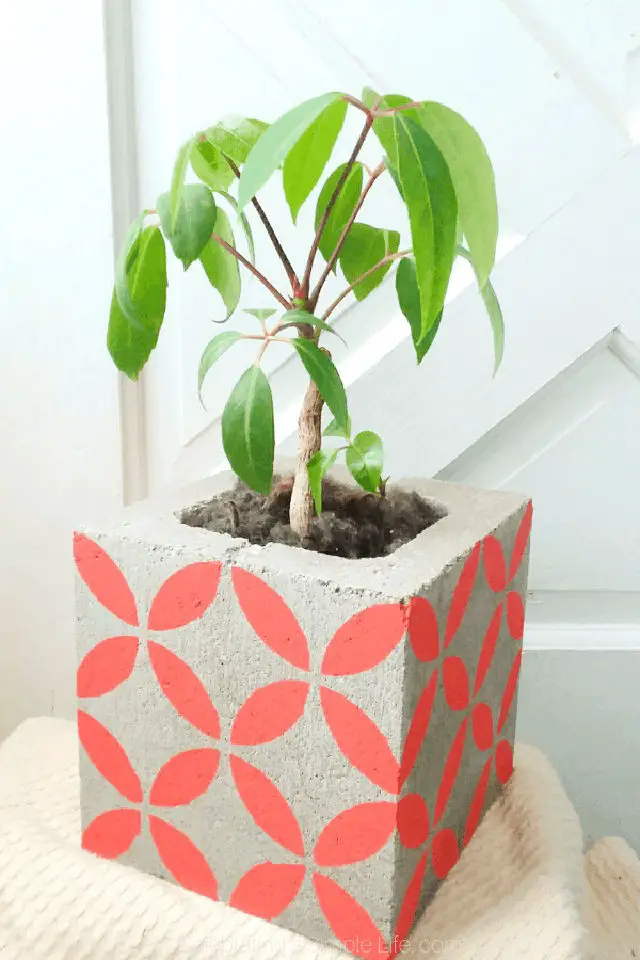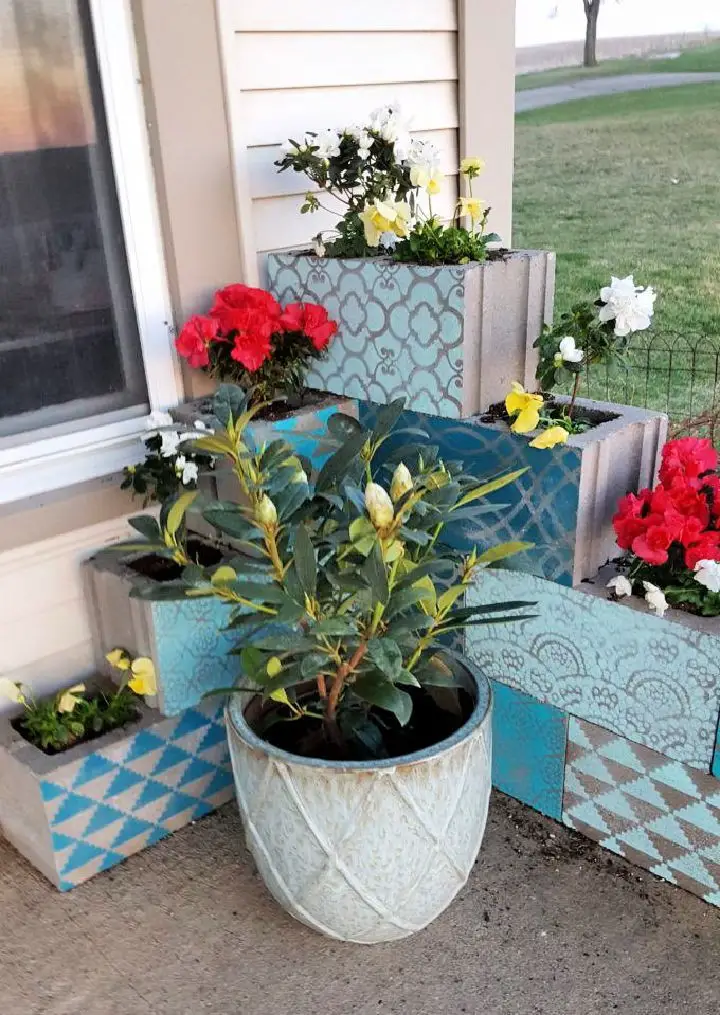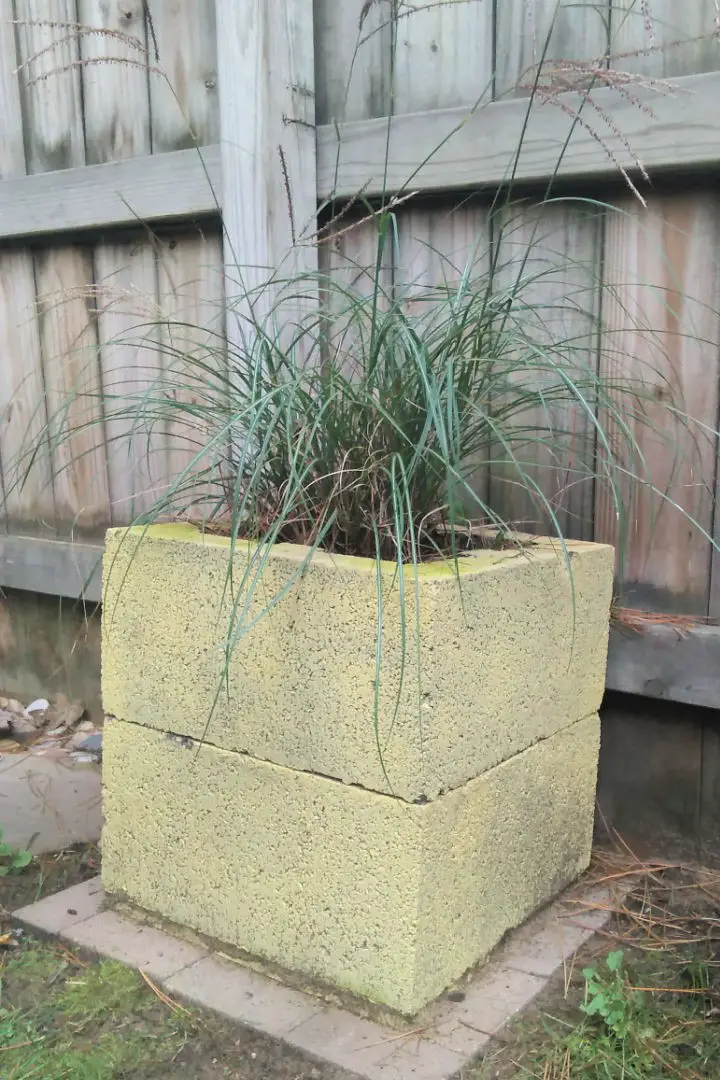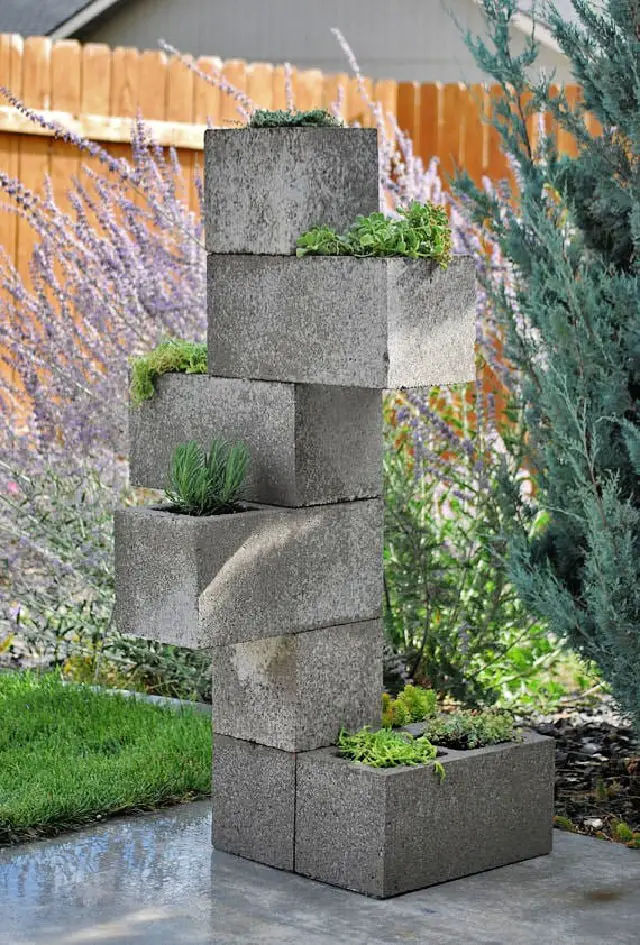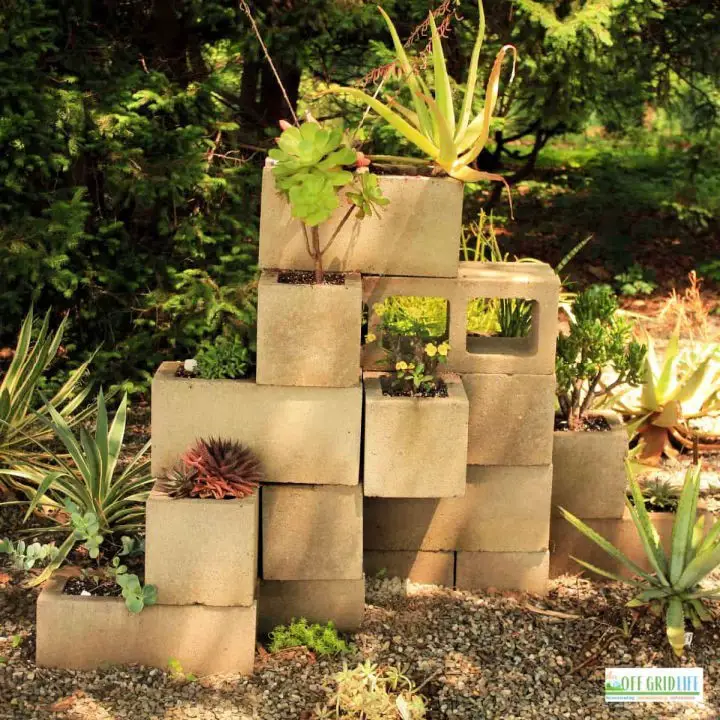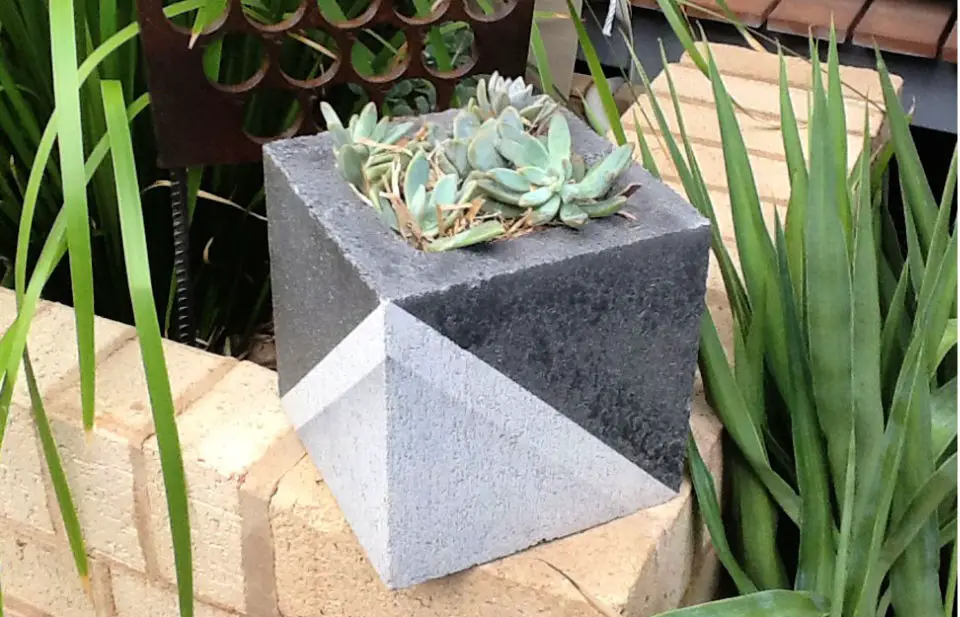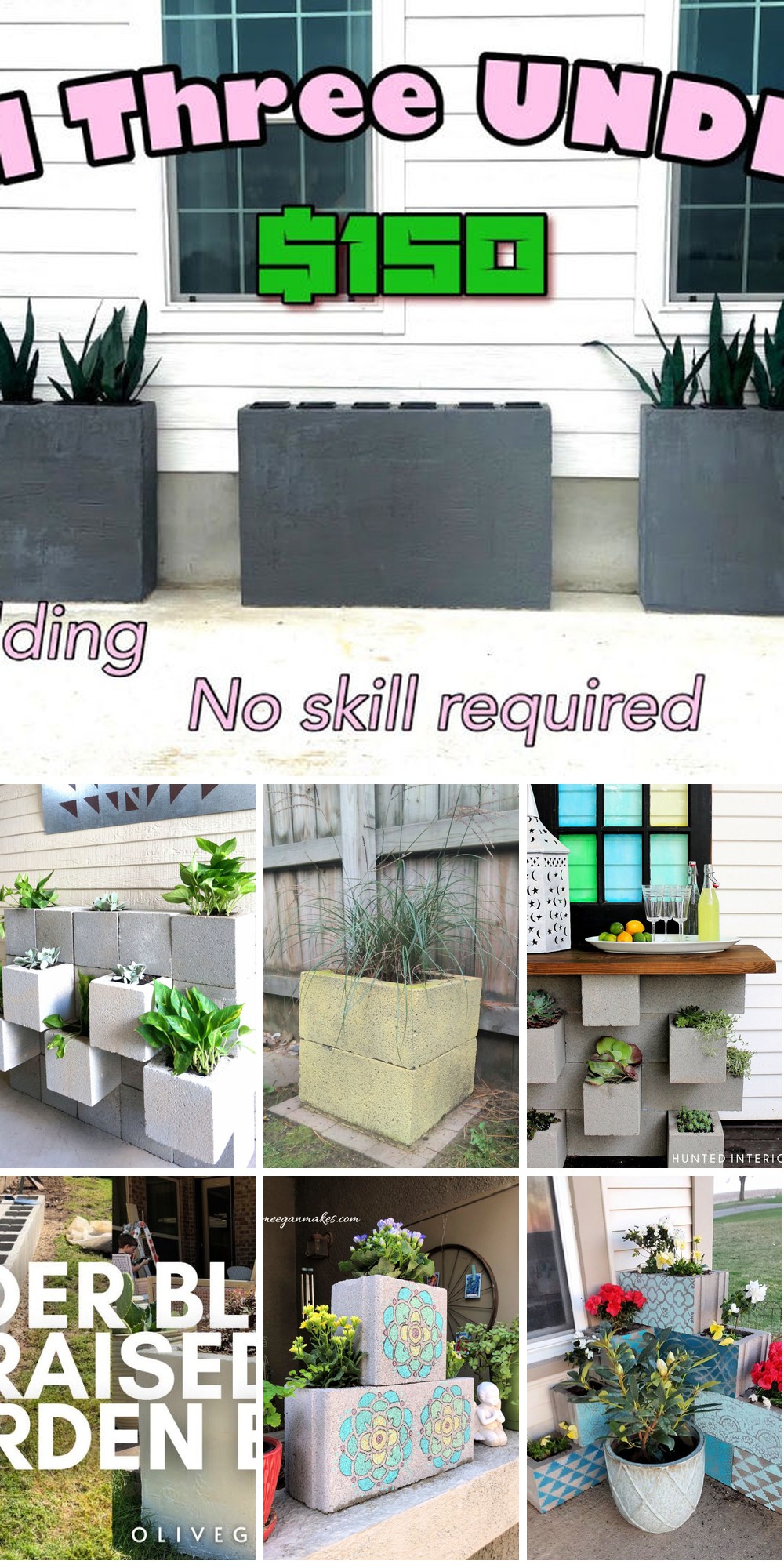
Transform any outdoor space into a thriving oasis by exploring 22 unique DIY cinder block planter ideas. To ensure long-term sustainability, learn how to select the perfect plants for your cinder block planters. If issues arise, discover troubleshooting tips to address common problems and adopt eco-friendly practices in your garden. Additionally, master essential maintenance techniques for your cinder block planters and gain insight into frequently asked questions to create a stunning garden haven. Ready to elevate your gardening experience? Dive into the world of creative design ideas and learn how to properly care for your plants and blocks. With these helpful tips and tricks, don’t miss the chance to build a beautiful and sustainable outdoor space.
How to Make a Cinder Block Planter – Step by Step Guide
Materials Needed
To build a unique and stylish planter box, you’ll need the following materials: Cinderblocks, which can be found at an affordable price on Facebook Market or at your local hardware store. For added convenience, a power washer can be used to clean any surfaces before construction. Additional essentials include a cement bonding agent, caulking gun, safety or gardening gloves for protection during the process, and mortar mix. Mixing the mortar requires water and a bucket, while plastic spatulas provide a budget-friendly alternative to traditional mortar spatulas. For finishing touches, consider using a sanding sponge (available in wood or cement) to smooth out any imperfections. To add some color and character to your planter box, use paint – peppercorn is a recommended choice. Once painted, apply the finish with a paintbrush or roller. Optional embellishments include faux snake plants for added greenery and black mulch to fill in empty spaces. For an extra layer of versatility, consider using planter boxes that can be inserted into cinderblock holes.
Step by Step Instructions
Step 1: Prepare the Cinderblocks
Before commencing with the construction of your planter, begin by thoroughly cleaning any dirt or debris from your cinderblocks. A power wash can be particularly effective in removing stubborn grime and ensuring a strong bond between the blocks and the paint or mortar that will follow. Once they’re sparkling clean, lay out your cinderblocks in their desired arrangement to visualize the final shape of your planter and make any necessary adjustments.
Step 2: Secure the Blocks
When it comes to building with concrete blocks, ensuring a strong bond between adjacent blocks is vital for both stability and long-term performance. To achieve this, apply a cement bonding agent to the sides and bottom of the blocks where they come together, a step that plays a critical role in preventing potential weaknesses and ensuring the structure remains safe and durable over time.
Step 3: Mix and Apply Mortar
To create a seamless bond between your cinderblocks and subsequent layers of material, you’ll need to prepare your mortar first. Start by mixing it with water in a bucket until the consistency is smooth and slightly runny, similar to pancake batter. Once you’ve achieved this consistency, use plastic spatulas to apply the mixture evenly over the cinderblock surfaces, aiming for complete coverage but not stressing if minor imperfections remain.
Step 4: Sand the Cinderblocks
After the mortar has fully dried and hardened, it’s essential to sand the block surfaces to eliminate any imperfections or unevenness. This crucial step enables you to achieve a more refined and even base for your subsequent painting endeavors.
Step 5: Paint the Blocks
Transform your cinderblocks into a stylish feature by painting them with a hue that reflects your personal taste. For a contemporary touch, consider peppercorn, a versatile color that can add a modern flair to any space. To achieve a seamless finish, ensure the paint is applied evenly to all surfaces, including the tops of the blocks, for a cohesive and visually appealing result.
Step 6: Add Faux Plants and Mulch
When incorporating your faux snake plants into a cinderblock arrangement, simply place them within the designated spaces or planter boxes. To achieve a sleek appearance, surround each plant with a thin layer of black mulch, carefully filling in any gaps to ensure a polished finish.
Step 7: Final Touches
As you arrange the faux plants, strive for a visually appealing arrangement that mimics the natural beauty of real foliage. Experiment with different configurations, adding or subtracting plants as needed to achieve the desired level of fullness and realism. It’s essential to strike a balance between the number and placement of plants to create a cohesive and inviting display.
Maintenance and Care
With faux plants requiring little to no upkeep, your focus can shift from routine maintenance to simply enjoying their aesthetic appeal. A quick dusting every now and then will keep them looking their best, while periodic inspections of the cinderblocks can help identify any minor issues that may arise over time, such as chips or fading paint, allowing for easy touch-ups.
Video Tutorial
To enhance your understanding of creating DIY Modern Cinderblock Planters with Faux Plants, I recommend watching a step-by-step video tutorial by Melanie Luna Diaz on YouTube. This visual guide complements the written instructions provided in this article, allowing you to see the techniques in action and gain a deeper appreciation for the process.
Creative Design Ideas for Cinder Block Planters
Elevate your outdoor haven by transforming ordinary cinder blocks into extraordinary planters. This DIY project is not only budget-friendly but also offers endless possibilities for creativity and self-expression. To spark your imagination, here are some innovative design ideas to kick-start your gardening journey:
Embrace Patterns and Colors
Transform your garden into a vibrant oasis by reimagining cinder blocks as an artistic canvas. With a few strokes of paint, you can create mesmerizing patterns that add a dash of personality to your outdoor space. Opt for a classic checkerboard design or go all out with abstract creations that will leave visitors in awe. This simple yet effective DIY project not only injects a splash of color but also invites creativity and self-expression, making it the perfect way to put your personal stamp on your garden.
Incorporate Artistic Elements
Transform your humble cinder block planters into a masterpiece by infusing them with creative flair. Turn each block into a work of art by crafting intricate mosaics, painting vibrant scenes, or adorning them with decorative tiles. This innovative approach not only adds an artistic touch but also creates a one-of-a-kind feature that’s sure to grab attention.
Mix and Match Plant Types
To create an eye-catching display, experiment with combining various plant species within your cinder block planters. Pair low-maintenance succulents with vibrant flowering plants or complement the earthy tones of leafy greens with fragrant herbs. The diverse textures and colors will add visual interest to your planter arrangement.
Selecting the Best Plants for Cinder Block Planters
When it comes to selecting plants for a cinder block planter, it’s essential to choose species that can tolerate the unique conditions found within this type of container. To achieve success with your cinder block planter, consider incorporating plants that have adapted to survive in areas with limited soil depth, moderate temperatures, and adequate sunlight. Some examples of plants that tend to thrive in these circumstances include…
Ideal Plants for Cinder Block Holes
When it comes to creating a thriving garden in small spaces like cinder blocks, certain plants stand out for their ability to thrive in compact conditions. Herbs such as basil, thyme, and oregano are well-suited to these areas, requiring minimal space to grow. For added visual appeal, flowers like marigolds, petunias, and pansies can add a pop of color. Meanwhile, vegetables like lettuce, spinach, and radishes are great choices for edible gardens, providing a nutritious harvest in even the smallest of spaces.
Consider Plant Needs
As you shop for plants to adorn your cinder block planter, take into account the specific needs of each species. Specifically, think about the amount of sunlight and water they require. This will help you select plants that thrive in their new environment, ensuring a harmonious coexistence with your chosen planter’s conditions.
Sustainability
When selecting plants, consider opting for species native to your region or those renowned for their natural resistance to drought. Not only will this environmentally conscious approach help preserve biodiversity, but it will also simplify upkeep and maintenance requirements.
Troubleshooting Common Issues with Cinder Block Planters
As you embark on creating your cinder block planter, you’ll likely face some obstacles. To overcome these hurdles and achieve success, consider the following strategies:
Ensuring Stability and Leveling
Before you begin planting, ensure that the terrain is even and flat. This will prevent any future issues with uneven growth or soil erosion. To achieve this, create a consistent pattern of block sizes throughout your planter. By using identical blocks, you’ll be able to pack them together tightly, which in turn will help to prevent soil from washing away during watering.
Dealing with Weight and Movement
When embarking on a cinder block project, it’s essential to take into account the weight of these materials. They can be quite heavy, so it’s crucial to plan your design with minimal movement in mind, taking into consideration your physical capabilities and limitations. This will not only save you energy but also reduce the risk of injury or strain. Additionally, when purchasing large quantities of cinder blocks, transportation becomes a significant factor. You may need to invest in a truck or trailer to accommodate the weight and bulk of these materials.
Aesthetic Consistency
When it comes to building with blocks, one crucial aspect is ensuring the blocks themselves are compatible. This means selecting pieces that share similar characteristics, such as textured surfaces or smooth ones, to create a cohesive visual effect. By doing so, you’ll be able to construct structures that boast a uniform appearance, free from any jarring inconsistencies.
Embracing Sustainability in Your Garden
Transforming your outdoor space into an eco-friendly haven using a cinder block planter is a rewarding endeavor that yields both environmental and personal benefits.
Sustainable Practices
By opting for eco-friendly solutions, you can create a sustainable and environmentally responsible planter that not only supports plant growth but also reduces waste. One effective approach is to utilize recycled or upcycled materials, transforming discarded items into functional planters. Additionally, conserving water is crucial in today’s world. You can do this by harnessing the power of rainwater for watering your plants and selecting drought-resistant species that thrive with minimal hydration.
Eco-Friendly Choices
When cultivating a thriving garden, consider embracing native plants specifically tailored to your region’s unique climate and ecosystem. Not only will these plants flourish with minimal maintenance, but they’ll also provide vital support for local wildlife populations. Additionally, opt for organic gardening practices by shunning chemical fertilizers and pesticides. Instead, utilize eco-friendly alternatives that promote plant health while safeguarding the overall well-being of the environment.
Essential Maintenance Tips for Your Cinder Block Planter
To prolong the life and appearance of your cinder block planter, regular maintenance is crucial. By following these uncomplicated guidelines, you can keep your planter looking its best throughout the entire year. First, inspect the exterior and interior surfaces for any signs of damage or erosion. If necessary, use a gentle cleaning solution to remove dirt and debris, taking care not to scrub too aggressively and damage the surface. Next, check the drainage system by pouring water into the planter. Ensure that water flows freely through the holes or gaps to prevent waterlogging, which can lead to root rot and other problems. If your planter has a liner or waterproofing coating, inspect it for any signs of wear and tear, replacing it if necessary. Finally, inspect the soil and plants within the planter, pruning or replanting as needed to maintain a healthy environment.
Regular Watering
To maintain the well-being of your plants, establishing a consistent watering routine is crucial. The schedule you implement will rely on the specific needs of each plant species and prevailing weather conditions. Aiming for consistency is vital, as this factor contributes significantly to overall plant health. Furthermore, it’s essential to prevent overwatering by ensuring proper drainage, which helps protect roots from waterlogging and associated damage.
Soil Care
To cultivate a thriving garden, it’s essential to focus on two fundamental aspects: nourishing the soil and controlling weed growth. First, replenish the soil with compost or organic matter to provide the necessary nutrients that plants need to grow. This can be achieved through the addition of decomposed plant material, animal waste, or even kitchen scraps. The benefits of nutrient-rich soil are multifaceted, including improved soil structure, increased water retention, and a boost in beneficial microorganisms. Next, implement a weed control strategy by removing unwanted plants promptly. This will prevent them from competing with your desired flora for essential resources such as light, water, and nutrients. By tackling these two crucial areas, you’ll be well on your way to creating a healthy and productive garden environment.
Block Maintenance
To ensure optimal performance, begin by thoroughly cleaning each block to remove any dirt, grime, or debris that may be hindering its functionality. For tougher stains, a mild detergent can be used in conjunction with a soft-bristled brush to gently scrub the area clean. Once the blocks are sparkling, conduct a thorough inspection to identify any cracks or damage that may require repair to maintain the overall integrity of the structure.
Seasonal Adjustments
When it comes to ensuring the health of your potted plants, seasonal care is crucial. In colder climates, take measures to protect your planter from frost by either covering it or relocating it to a sheltered spot. This simple step can make all the difference in preventing damage and promoting healthy growth.In contrast, during hot summer months, mulching around your plant’s base can be incredibly beneficial. Not only does it help retain moisture, but it also works to keep the roots of your plants at a comfortable temperature, reducing stress and promoting overall well-being.
FAQs About DIY Cinder Block Planters
When it comes to adding a personal touch to your garden, cinder block planters are a creative solution that has gained popularity among DIY enthusiasts. As you embark on this project, you may encounter several questions and concerns. Here’s what you need to know to make the most out of these planters.
What is the best way to arrange cinder blocks for a planter?
When it comes to arranging cinder blocks in your garden, the key is to find a layout that complements the unique dimensions and character of your outdoor space. This may involve stacking the blocks in a classic rectangular formation, but don’t be afraid to think outside the box and try more innovative designs such as zigzag or circular patterns. The possibilities are endless, and with a little creativity, you can create a visually appealing and functional structure that enhances the beauty of your garden.
Do I need to use mortar to secure the blocks?
While mortar isn’t typically required for a cinder block planter, as the weight of the blocks tends to be sufficient for keeping them stable, there may be instances where additional support is necessary. For instance, if you’re constructing a tall structure, using a construction adhesive can provide an extra layer of stability and help prevent the blocks from shifting or toppling over.
How do I ensure proper drainage in my cinder block planter?
When constructing a planter using cinder blocks, it’s crucial to ensure that any holes or gaps within the blocks remain unobstructed, allowing for free-flowing water drainage. To further enhance drainage, consider adding a layer of gravel at the bottom of the planter before introducing soil, as this will help facilitate the smooth flow of excess moisture away from the roots.
Can I grow vegetables in a cinder block planter?
Vegetables can indeed flourish in a cinder block planter, as long as you provide sufficient depth for their roots to develop and place it in a spot that receives ample sunlight. The key is striking the right balance between root growth and solar exposure.
Is it safe to use old cinder blocks for a planter?
When it comes to building garden beds using cinder blocks, it’s generally recommended to opt for new blocks from a reputable home improvement store instead of utilizing older ones. This is particularly crucial when cultivating edible plants, as older blocks may harbor harmful toxins that can contaminate the soil and pose potential risks to your crops. By selecting fresh, untainted blocks, you can ensure the quality and safety of your garden’s soil, giving your plants the best possible chance to thrive.
How can I prevent soil from washing out of the blocks?
When constructing a retaining wall to prevent soil erosion, it’s crucial to ensure that each block fits seamlessly into place. Any minor gaps that may occur can be efficiently filled using fragments of cinder blocks or rocks that are carefully fitted together, thereby maintaining the structural integrity and aesthetic appeal of the wall.
What kind of plants are best suited for cinder block planters?
Succulent enthusiasts and garden novices alike can find success in using cinder block planters, as they provide a suitable environment for certain types of plants that don’t demand deep soil. A prime example is succulents, herbs, and some flowers. For the gaps within the blocks, look to plant species with relatively shallow root systems, which are often better suited for these shallow containers.
How can I protect my cinder block planter in winter?
When winter’s chill sets in, take steps to safeguard your planter and its contents. In areas prone to frost, consider relocating it to a protected spot or covering it with a breathable material to shield the soil from harsh temperatures. Additionally, apply a layer of mulch to insulate the earth and promote healthy root growth throughout the cold season.
Can I paint my cinder block planter?
If you’re looking to harmonize your cinder block planter with its surroundings, painting it is a viable option. To achieve a smooth finish, begin by applying a coat of primer specifically designed for outdoor use. This will help create a strong bond between the paint and concrete, ensuring a long-lasting and weather-resistant finish.
How often should I water plants in a cinder block planter?
When it comes to watering, timing is everything. The frequency of your watering sessions ultimately depends on the specific needs of your plants, as well as the local climate. To determine if your plants need a drink, simply stick your finger into the soil up to the first knuckle. If the top inch feels dry to the touch, it’s time to give them some much-needed hydration.
22 DIY Cinder Block Planter Ideas
Revitalize your outdoor area with a unique blend of functionality and aesthetics by exploring 22 innovative DIY cinder block planter concepts. Ranging from striking vertical garden installations to fragrant herb garden designs, this inspiring collection is sure to spark a creative transformation of your exterior space.
How to Make a Concrete Block Planter Box
Transform your outdoor space into an inviting haven by creating a DIY concrete block planter box that’s as budget-friendly as it is visually striking. This straightforward yet impressive project can add depth and interest to your garden or patio, making it the perfect focal point for any outdoor oasis.With just a handful of materials including concrete blocks, construction adhesive, primer, paint, and gravel, you can construct a robust planter box that will comfortably hold a generous amount of soil and withstand the weight of your plants. A step-by-step guide will walk you through washing and painting the blocks, assembling the planter box, and ensuring proper drainage. Once complete, fill it with your favorite flowers or plants to create a stunning centerpiece in your outdoor retreat.
Make a Cement Block Garden Planter
To elevate your porch, balcony, or home decor, create a DIY cement block garden planter by following this comprehensive guide. Start by gathering materials: cement blocks, real flowers, potting soil, a plastic liner, exterior paint in various colors, stenciling brushes, a fine-tip Sharpie marker, scissors, and masking or painter’s tape. Then, unleash your creativity and make a boho-inspired design by stenciling patterns onto the blocks using beach-toned paint samples. Achieve a unique semi-ombre effect with lavender details and outline the painted areas with the Sharpie marker for added visual interest. Stack the blocks, ensuring proper drainage by lining them with plastic, and finally, plant the flowers. This project yields stunning cement block garden planters that are sure to impress your neighbors and charm your outdoor space.
Colorful DIY Cinder Block Garden Ideas
Create a show-stopping DIY color-blocked cinder block succulent garden without breaking the bank! Start by stacking single and double cinder blocks to form a multilevel structure, leaving gaps between the blocks for planting succulents. This unique arrangement brings together contrasting textures – concrete and natural foliage. To add an extra splash of color, tape off triangular sections on the blocks and give them a vibrant makeover with spray paint. When it comes to filling each cubby, get creative by dividing larger succulent plants into smaller ones, saving you money in the process. Once planted, simply water sparingly, as succulents are notoriously low-maintenance. With this budget-friendly project, transform your outdoor space into a stunning oasis that’s sure to impress!
Adorable Painted Cinder Block Planter
This autumn, elevate your patio decor with an innovative DIY project: transforming ordinary cinder blocks into one-of-a-kind planters. To get started, gather supplies like cinder blocks, stencils (such as the plaid design from Stencil 1), craft paint, foam brushes, and a mason jar. Simply apply the stencil to the block, use an up-and-down blotting motion to add color, remove the stencil, and repeat on all sides for a unique look.
Once your blocks are painted, fill them with your favorite fall flowers or foliage for a charming touch that will surely impress your guests. This budget-friendly project is the perfect way to add a pop of color to your outdoor space this season.
Easy DIY Painted Cinder Block Planters
Transform ordinary spaces into extraordinary settings with an innovative DIY centerpiece project that’s both budget-friendly and visually striking. Ditch pricey pots for affordable cinder blocks, which provide a clean slate for your creativity. Start by applying painter’s tape to create the desired color blocking and then coat the blocks with acrylic paint in multiple layers. Once dry, fill the openings with crumpled newspaper or paper towels to create a base, followed by planting succulents in plastic bags to prevent soil spillage. Finally, place the plants in their new homes and add a touch of elegance with white rocks. The possibilities are endless when it comes to customizing these centerpieces to fit any occasion, making them a unique and cost-effective way to elevate your decor.
Make a Cinder Block Garden – Step by Step
Transform your outdoor space into a captivating green oasis with our DIY cinder block planter ideas, where artistic arrangements meet functional design. This versatile project is perfect for those looking to create a unique and water-efficient garden for herbs or succulents. With just a few materials like cinder blocks, potting soil, herbs, succulents, galvanized wire mesh, and garden fabric, you can build a custom-sized planter that not only adds visual appeal but also provides structural support and durability through the galvanized steel strips. This cost-effective and creative solution allows you to embrace gardening while adapting to drought conditions, making it an ideal choice for those looking to conserve water. By embracing this innovative cinder block planter, you can enjoy the beauty of nature while minimizing your environmental impact.
Simple Cinder Block Succulent Wall With a Twist
Transform your outdoor space into a stunning oasis by crafting a contemporary DIY cinder block wall planter. This innovative project simplifies the process, eliminating the need for chicken wire, allowing you to directly place plastic pots within the cinder block openings. With minimal requirements including cinder blocks (both standard and half-size), chosen plants, plastic pots, potting soil, and a broom for cleaning, this project is surprisingly straightforward. Follow the step-by-step instructions to assemble the wall, adding your preferred greenery, and enjoy the end result – a modern design that effortlessly combines style and functionality. As you bring your plant wall to life, take pleasure in the creative process and bask in the beauty of your handcrafted outdoor haven.
Homemade Cinder Block Planters
Transform bare spots in your yard into stunning works of art by crafting DIY vertical planters using cinder blocks! This comprehensive guide takes the mystery out of building, providing step-by-step instructions on how to stack, prime, and paint these blocks to create unique planter sculptures. With a little creativity and some basic materials, you’ll be able to add a touch of greenery and whimsy to your outdoor space in just a few days. Follow along as we explore the essential tips and techniques needed to bring your vertical planters to life, from selecting the perfect plants to allowing for proper drying time. Get ready to unleash your inner artist and watch your yard transform into a lush and vibrant oasis.
Modern Stenciled Cinder Block Planters
Transform your gardening experience with customized DIY planters that combine form and function. Unlike traditional concrete block planters, these stenciled wonders feature a drainage hole at the bottom, making it effortless to relocate your plants without compromising soil integrity. Create your own masterpiece using readily available materials such as concrete blocks, Quickrete concrete mix, and Stencil Revolution’s versatile designs. Begin by pouring the concrete base into each block, then add a beeswax or crayon plug for the drainage hole. Finally, stencil your desired pattern onto the planters to give your patio a quick, affordable, and charming makeover.
Gorgeous DIY Concrete Block Planter
Transforming your backyard parties with a functional DIY concrete block planter bar is an innovative way to elevate the ambiance. To create this unique piece, begin by arranging the blocks in a stable pattern, carefully staggering the seams for added structural integrity. Secure the blocks together using a robust adhesive, ensuring the structure remains sturdy and solid. Once the adhesion has set, level the bar with wood shims and let it cure. When the bar is ready, create a suitable planting area by securing hardware and landscape cloth in place. Fill the space with vibrant succulents to add a pop of color and texture. For an added touch, attach wooden boards to create a tabletop using weatherproof adhesive and metal plates. Finally, hang artwork above the bar to complete the look and set the tone for your outdoor gathering. As you relax with refreshing lemonade and gaze out at your newly transformed space, you’ll be eager to plan future projects and make unforgettable memories.
DIY Stenciled Cinder Block Planter for Corner
Elevate your outdoor space with DIY cinder block planters that blend functionality, style, and eco-friendliness. By repurposing ordinary cement blocks into unique containers, you can create a one-of-a-kind corner planter that adds personality to your front porch. The process is surprisingly easy, requiring minimal effort yet yielding impressive results. Simply stencil and spray paint the blocks with vibrant colors to add visual appeal, then fill them with your favorite blooms and greenery. As an added bonus, using organic soil and plant food from EcoScraps promotes sustainability and reduces waste. Let your creative gardening skills shine and transform your outdoor space into a charming haven.
Cheap DIY Concrete Block Planter Idea
Transform your backyard into a charming oasis by crafting a functional garden seating area using DIY concrete block planters. This step-by-step guide will show you how to upcycle recycled concrete blocks into stylish containers, perfect for adding a beachy vibe to your outdoor space.
Start by selecting the size and shape of blocks that fit your design aesthetic and give them a fresh coat of spray paint in your desired color. Stack the blocks to create the desired height and fill with soil, then add your favorite plants. To ensure proper drainage and conserve soil, consider placing empty water bottles at the bottom of each planter.
With this creative and budget-friendly project, you can enhance your outdoor space without breaking the bank. So why not get started today and create a beautiful and functional garden seating area that’s sure to be the envy of all your friends?
Inexpensive Cinder Block Garden
Transform dull spaces into a lush oasis with this innovative DIY cinder block planter project. By combining creativity and elbow grease, you can create a stunning vertical garden that adds beauty and life to your surroundings. Unlike traditional horizontal planters, this unique design gives your outdoor space an urban garden flair.
To bring this project to life, simply gather a few essential supplies, including cinder blocks, metal flashing rectangles, landscape adhesives, and your choice of plants. Then, let your creativity shine by arranging the blocks in a way that suits your style and desired size. Follow our easy-to-follow instructions to adhere caps to the bottom of the planters for drainage, assemble the sections, and plant with lightweight soil and your favorite greenery.
Whether you’re an avid gardener or looking for a creative way to enhance your outdoor decor, this DIY cinder block planter is sure to impress. So why not give it a try? Share your photos and save this idea for future projects!
Homemade Cinder Block Planter

Transform your outdoor space into a breathtaking oasis by crafting a stunning DIY cinder block planter. This easy-to-follow tutorial requires just a few simple materials, including cinder blocks, heavy-duty all-weather glue, landscaping fabric, scissors, soil, and your choice of flowers or plants. By following the step-by-step instructions in the accompanying video, you’ll be able to create a one-of-a-kind garden masterpiece that showcases your personal style. So why not let your creativity bloom and give this simple yet effective DIY project a try?
Beautiful DIY Stenciled Cinder Block Planters
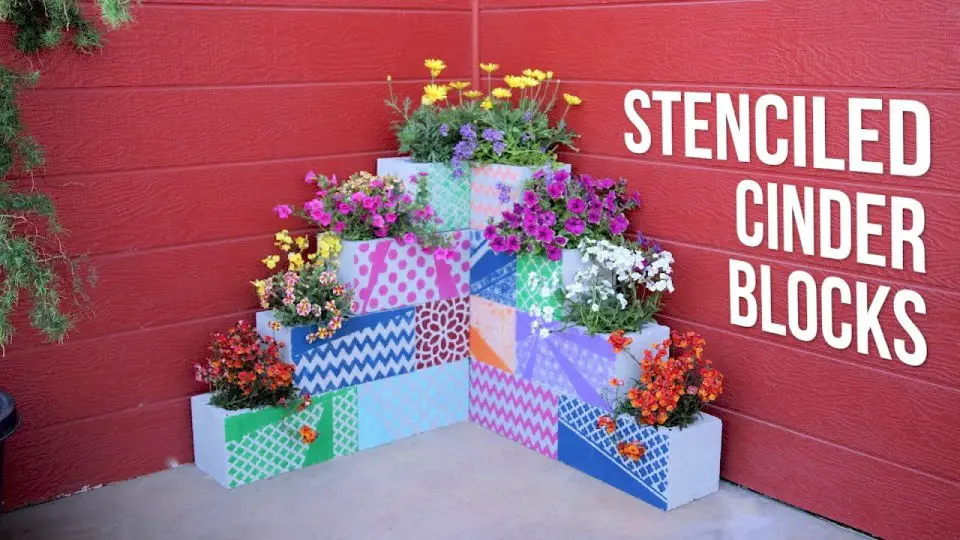
Elevate your garden’s aesthetic with DIY stenciled cinder block planters, a creative project that transforms ordinary blocks into extraordinary vessels. This engaging tutorial walks you through the process of upcycling plain cinder blocks using stencils and exterior paint, offering endless customization possibilities to match your personal style. The video also provides a comprehensive list of required materials, including cinder blocks, landscape fabric, and exterior paint, ensuring that you’re well-prepared to tackle the project. By following this step-by-step guide, you’ll be able to craft one-of-a-kind planters that add a dash of charm to your outdoor space.
Cheap and Easy Cinder Block Succulent Garden
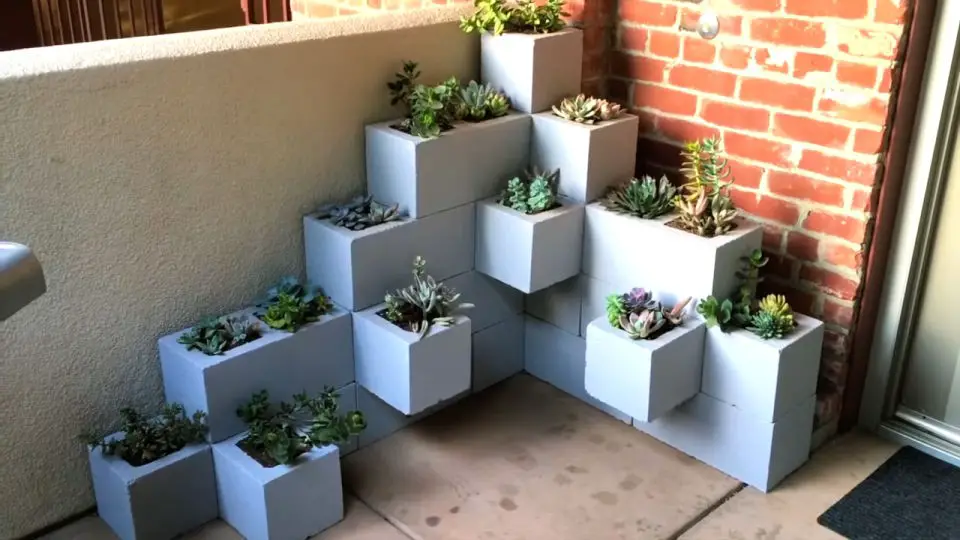
Transform limited spaces into stunning gardens without breaking the bank! Our DIY cinder block planter ideas offer a low-maintenance, modern solution for small areas. By repurposing inexpensive cinder blocks costing only USD 1.50 each, you can create a chic succulent arrangement that brings a touch of nature indoors. This budget-friendly project requires minimal materials and provides essential tips to ensure success. Explore the creative possibilities and elevate your decor with this trendy succulent planter.
How to Make a Monogrammed Cinder Block Garden
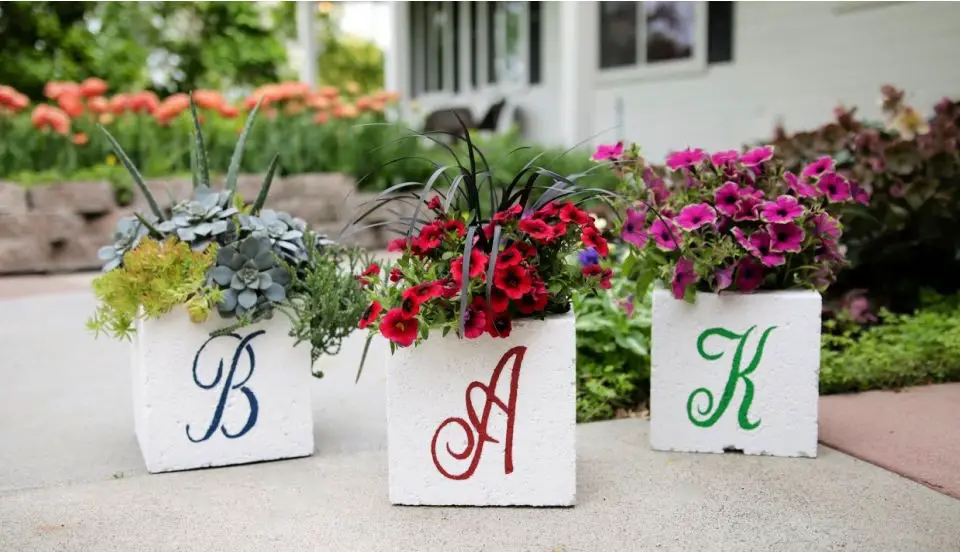
Elevate your outdoor space with a one-of-a-kind DIY monogrammed cinder block planter that reflects your personal style. By combining simple materials like cinder blocks and succulents, you can create a breathtaking display of elegance and functionality. This clever DIY project lets you customize the design to feature your initials or any other creative motif you envision. With easy-to-follow instructions, you’ll be able to craft a stunning planter that will surely spark envy from your neighbors. Get ready to transform your garden with this unique and eye-catching monogrammed cinder block planter.
Painted Cinder Block for Flower Planters
Elevate your outdoor space by turning plain cinder blocks into stunning planters through a simple yet creative DIY process. With MyCrafty Stencils’ high-quality patio paint and unique designs, you can transform these ordinary building materials into extraordinary works of art. Whether you’re drawn to the vibrant hues of peacocks or the intricate patterns of mandalas, their extensive range of stencils ensures your planter reflects your personal style. As the summer season approaches, why not inject some creativity and personality into your garden or patio? Follow this easy DIY guide, visit MyCrafty Stencils to purchase the necessary materials, and get ready to unleash your artistic flair on the great outdoors.
Build a Cinder Block Flower Garden
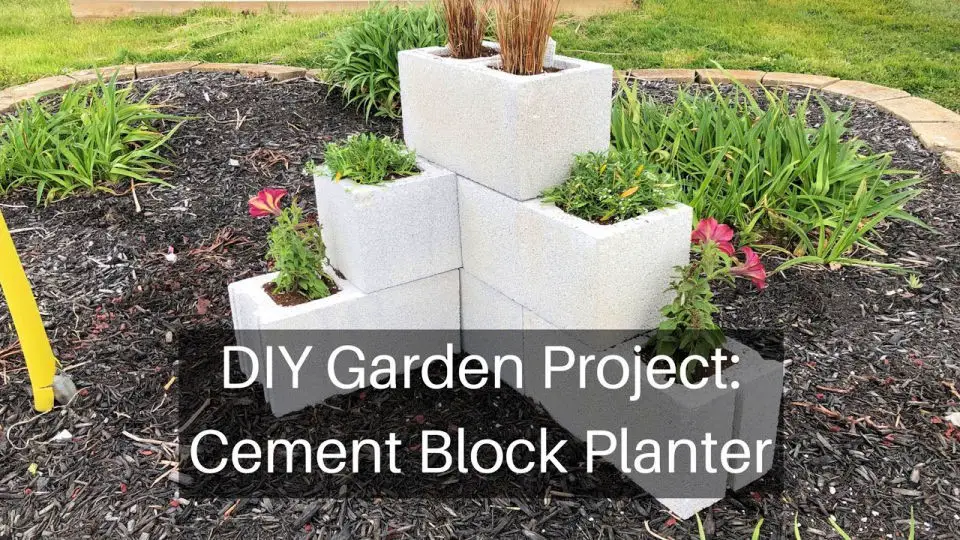
Transform your outdoor space into a vibrant haven by crafting a stunning and budget-friendly flower planter using cinder blocks, soil, and flowers. This straightforward DIY endeavor requires no specialized tools or intricate techniques, making it accessible to everyone. With this simple yet stylish creation, you’ll be able to bring a touch of nature’s beauty to your garden, as blooming flowers add a pop of color and charm. Simply follow the easy-to-understand video tutorial and get ready to turn your backyard into a lively oasis that’s sure to delight.
Make Your Own Cinder Block Succulent Planter
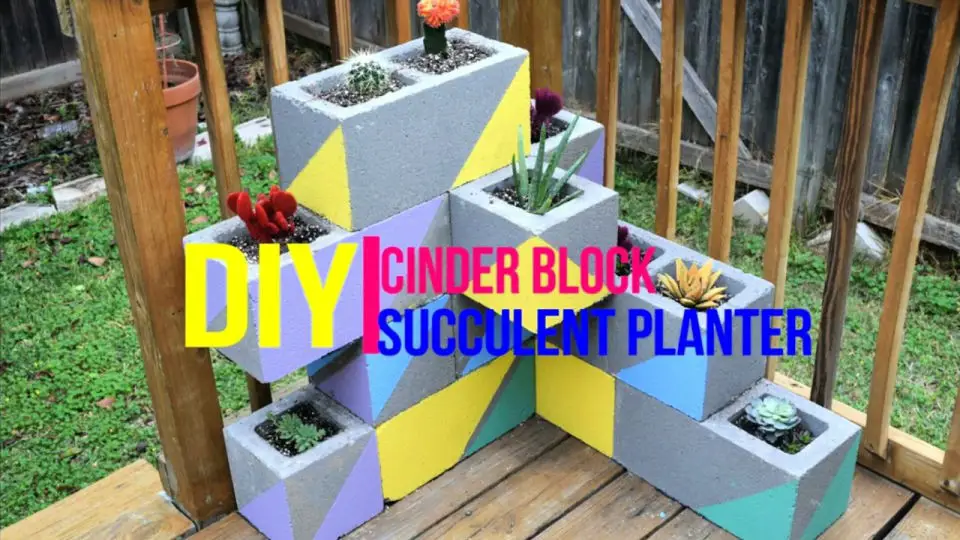
Elevate your outdoor space with a touch of industrial chic using these innovative DIY cinder block planter ideas, perfect for urban gardeners and green thumbs alike. By repurposing concrete masonry units, you can create a one-of-a-kind succulent planter that adds a pop of color and vibrancy to your outdoor area. This easy-to-follow tutorial guides you through the process, making it accessible to both beginners and experienced DIY enthusiasts. With this project, you’ll not only add a unique decorative element to your backyard but also enjoy the beauty of succulents in a stylish and cost-effective way.
Make Cinder Block Planters With Step by Step Instructions

Transform your surroundings into a stylish and budget-friendly haven by creating three modern planters using cinderblocks, all for under $150 (excluding the cost of plants). This DIY project boasts a sleek design that requires no special skills to assemble, making it accessible to both beginners and experienced DIY enthusiasts. By incorporating these unique planters into your indoor or outdoor space, you’ll be able to bring in a touch of nature while adding a chic flair to your home decor with minimal hassle.
Cool Raised Planter Box From Cinder Blocks
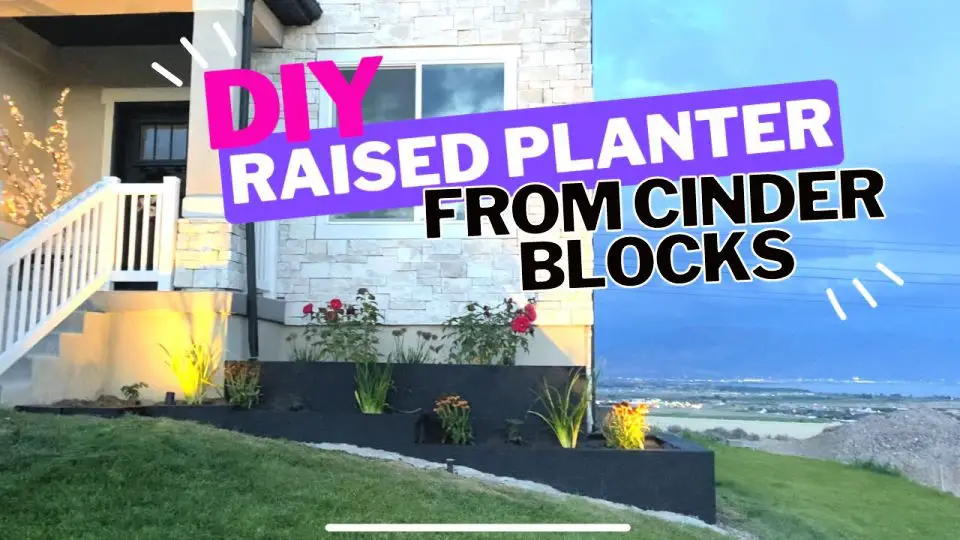
Transform your garden into a breathtaking oasis with a clever DIY raised planter constructed from cinder blocks. This straightforward yet impactful project demands little effort, yielding impressive results. Learn how to create your own masterpiece today! By substituting traditional concrete footings for rock and block adhesive, this tutorial streamlines the construction process, ensuring stability and durability. Filled with soil and rock, the planter is designed to withstand minor settling, making it perfect for dry climates. Explore this innovative and budget-friendly gardening solution that leverages readily available materials to create a stunning addition to your outdoor space.
How to Build a Vertical Cinder Block Garden
Transform your outdoor space into a thriving oasis by creating a DIY cinder block planter that’s both eco-friendly and cost-effective. Unlike traditional methods, this approach utilizes concrete blocks instead of cinder blocks, eliminating the risk of harmful toxins. To get started, define the size and height of your garden, calculate the number of blocks needed, and map out the footprint. Begin by laying the blocks, ensuring they’re level and secure. Next, line the interior with a weed barrier to prevent unwanted growth. Finally, fill the blocks and surrounding areas with high-grade soil and plant flowers or vegetables. This project requires minimal labor and expenses, making it an accessible way to establish a raised bed garden that’s both functional and visually appealing.
DIY Concrete Block Planter
Bring a touch of elegance to your outdoor space without breaking the bank by creating your own DIY planter boxes. Made from sturdy concrete blocks, this innovative project offers endless design possibilities, from single-level to multi-tiered structures. By following our straightforward guide, you can unleash your creativity and transform your garden into a serene retreat that’s not only visually stunning but also budget-friendly.
DIY Raised Planter From Cinder Blocks

Transform your outdoor space into a serene oasis by constructing a raised planter using cinder blocks, as showcased in this captivating video. The project’s highlight is the harmonious integration of a fountain, creating a peaceful ambiance that will surely impress fellow garden enthusiasts. With this step-by-step guide, both seasoned and novice gardeners can learn to craft their own elevated planters, perfect for showcasing their green thumb. This comprehensive tutorial not only provides inspiration but also offers practical advice on how to elevate your gardening skills.
Conclusion:
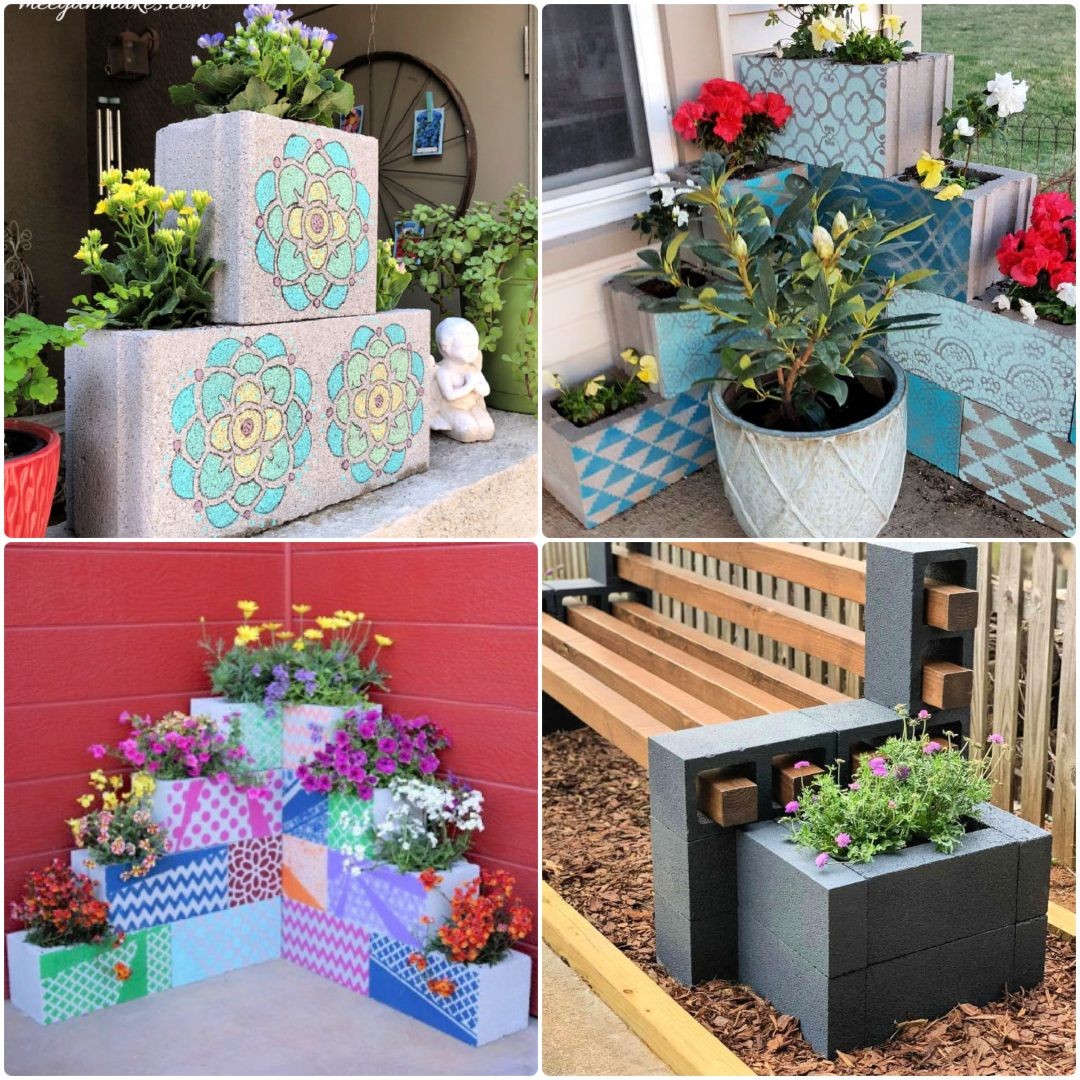
As we conclude this comprehensive guide to 22 DIY cinder block planter ideas, it’s clear that creative design tips, expert plant selection advice, troubleshooting solutions, sustainable practices, and maintenance tips have been woven together to create a treasure trove of inspiration for your outdoor haven. Whether you’re just starting out in the world of gardening or are an experienced green-thumbed pro, these innovative projects offer a boundless array of possibilities for transforming your space into a unique and thriving oasis.

